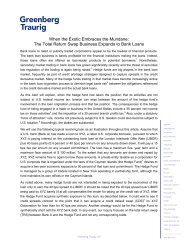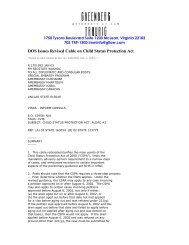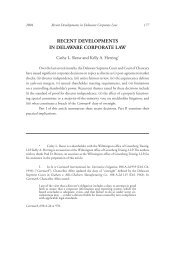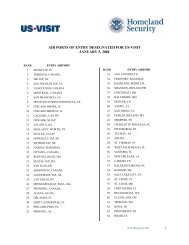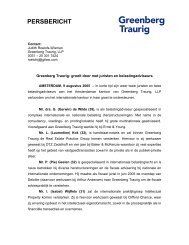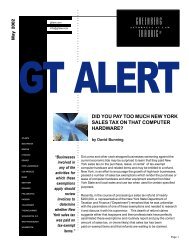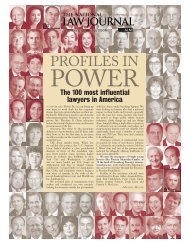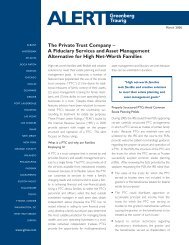U.S. Supreme Court Restricts First Amendment Rights of Public ...
U.S. Supreme Court Restricts First Amendment Rights of Public ...
U.S. Supreme Court Restricts First Amendment Rights of Public ...
Create successful ePaper yourself
Turn your PDF publications into a flip-book with our unique Google optimized e-Paper software.
The majority criticized the Ninth Circuit’s reasoning,<br />
stating that it “misconceives the theoretical<br />
underpinnings <strong>of</strong> our decisions.”The court explained<br />
that employees who “make public statements outside<br />
their <strong>of</strong>ficial duties” retain <strong>First</strong> <strong>Amendment</strong><br />
protections because they are engaged in the same<br />
kind <strong>of</strong> activity as citizens who do not work for the<br />
government. “When a public employee speaks<br />
pursuant to employment responsibilities, however,<br />
there is no relevant analogue to speech by citizens<br />
who are not government employees.”<br />
The majority also criticized the Ninth Circuit’s remark<br />
that it would be anomalous to require public<br />
employers to tolerate public criticism,while permitting<br />
them to restrict speech on the job. The majority<br />
noted that public employers “have the means at hand<br />
to avoid” this anomaly, by allowing internal criticism<br />
if they wish to encourage internal complaints.<br />
Justices Stevens, Souter, and Breyer wrote dissenting<br />
opinions. Justices Stevens and Ginsburg joined in<br />
the Souter dissent. All three dissenting opinions<br />
criticized the majority’s distinction between public<br />
employees “speaking as citizens” and “speaking in<br />
the course <strong>of</strong> employment.” The Souter dissent<br />
proposed an adjustment <strong>of</strong> the Pickering balancing<br />
test, which would permit public employers to restrict<br />
employee speech unless the employee “speaks on<br />
a matter <strong>of</strong> unusual importance” and “satisfies high<br />
standards <strong>of</strong> responsibility” in so doing. Justice<br />
Souter also warned that public employers could<br />
restrict employees’ <strong>First</strong> <strong>Amendment</strong> rights by<br />
drafting broad job descriptions that bring most<br />
communications within the employees’ <strong>of</strong>ficial<br />
duties. Finally, Justice Souter opined that application<br />
<strong>of</strong> the majority’s reasoning to a public university<br />
could infringe on academic freedom.<br />
The majority did not address Justice Souter’s proposed<br />
“adjustment” <strong>of</strong> the Pickering balancing test.<br />
It did “reject” his suggestion that excessively broad<br />
job descriptions could limit employee rights, noting<br />
that job descriptions do not necessarily track actual<br />
employee duties.The majority noted the academic<br />
freedom argument and declined to consider<br />
whether its analysis should be applied to scholarship<br />
or teaching cases.<br />
The majority referred to “sound principles <strong>of</strong> federalism<br />
and the separation <strong>of</strong> powers” in support<br />
<strong>of</strong> its decision, without explaining those principles<br />
further. The court apparently meant to express<br />
disapproval <strong>of</strong> judicial intervention in employment<br />
decisions made by the executive branches <strong>of</strong> state<br />
governments. The court concluded, “The <strong>First</strong><br />
<strong>Amendment</strong> does not prohibit managerial discipline<br />
based on an employee’s expressions made<br />
pursuant to <strong>of</strong>ficial responsibilities.”<br />
The Final Word<br />
The Garcetti majority assisted public employers in<br />
at least two respects. <strong>First</strong>, by establishing a<br />
“bright-line” rule, the majority affords public<br />
employers greater certainty when dealing with<br />
thorny free speech issues involving public employees.<br />
Second, by drawing this bright line at the far end<br />
<strong>of</strong> public employee conduct, the Garcetti decision<br />
provides employers with substantial authority to<br />
restrict public employees’ speech activities, for better<br />
or for worse.<br />
<strong>Public</strong> employers should carefully consider Garcetti<br />
and reevaluate policies and practices in this area.<br />
In light <strong>of</strong> the Garcetti bright line rule, public<br />
employers’ written policies should be revised,<br />
where needed, to fully inform public employees <strong>of</strong><br />
the proper boundaries <strong>of</strong> public discourse by public<br />
employees. Notwithstanding the debate between<br />
the Garcetti majority and minority camps on the<br />
breadth <strong>of</strong> job descriptions, public employers<br />
should consider reevaluating current job descriptions<br />
to ensure that certain speech activities are<br />
properly described as job functions.<br />
U.S. <strong>Supreme</strong> <strong>Court</strong> <strong>Restricts</strong> <strong>First</strong> <strong>Amendment</strong> <strong>Rights</strong> <strong>of</strong> <strong>Public</strong> Employees Page 2



